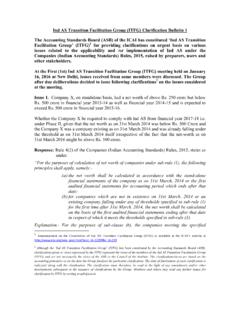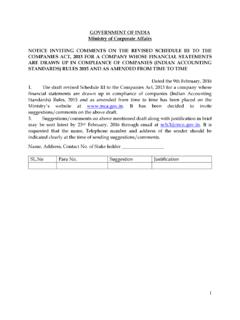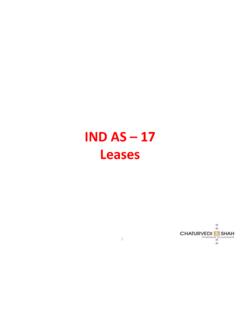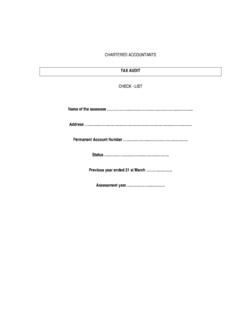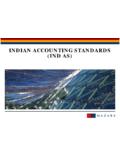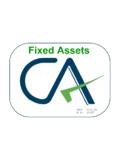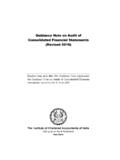Transcription of IND AS 1- Presentation Of Financial Statement
1 IND AS 1 Presentation of Financial Statement Objectives and scope of Ind AS 1 Components of financials Statements Key Principles Structure of Financial Statements Key Differences Objectives and scope of Ind AS 1 3 Objective IND AS 1 describes Financial statements as a structured representation of the Financial position and financials performance of an entity. Objective of the Financial Statement is to provide useful information about the: Financial Position (Assets, Liabilities & equity) Financial Performance (Income, Expenses including gains and Losses) Cash Flows (Including Cash Equivalents) 4 Scope IND AS 1 applies in preparing and presenting general purpose Financial Statement Other IND AS set out recognition, measurement and disclosure requirements of specific transactions and events IND AS 1 prescribes the basis for Presentation of Financial statements to ensure comparability both with: Entity s own Financial statements of previous periods.
2 And Financial Statements of other entities. 5 Components of Financial statements 6 Components of Financial Statements Balance sheet as at the beginning of the earliest comparative period when IND AS 8 applies Balance Sheet Statement of Profit and Loss with other comprehensive income Statement of changes in equity. Statement of Cashflows Significant accounting policies and other explanatory notes Components of Financial Statements 7 With comparative information of previous year IFRS permits separate other comprehensive Statement Entities may present additional information on a voluntary basis with are outside the scope of IND AS, for example Environment Reports, Value added statements, review by management including Financial and other commentary 8 Draft Sch III IndAS requires any change in treatment or disclosure, Sch III stand modified Disclosure as per Sch III are in addition to Ind AS and not substitution.
3 Additonal disclosure to be made if any Act/regulation requires in additional to IndAS and Sch III Key Principles 9 Key Principles True and Fair View Compliance With IND AS Going Concern Accrual Basis of Accounting Materiality and Aggregation Offsetting Frequency of Reporting Comparative Information Consistency of Presentation 10 True and Fair View IND AS 1 requires that Financial statements true and fair view of the Financial position, Financial performance and cash flows of the entity. A Presentation of true & fair view requires an entity to select and apply accounting policies as per IND AS 8. Cannot rectify inappropriate policy by disclosure or note If management concludes compliance with an IND AS is misleading and conflicts with objective, departure from that Standard requires Comprehensive disclosure requirements Only if relevant regulatory framework requires or does not prohibit Extremely rare 11 Compliance with IND AS IND AS 1 requires an explicit and unreserved Statement of compliance with IND AS to be included in the notes.
4 Compliance with all the applicable IND AS s. 12 Going Concern An entity is a going concern unless: Cease business trading Intends to liquidate or no realistic alternative but to do so. Management shall make an assessment of an entity s ability to continue as a going concern When financials are not prepared on a going concern basis, the Financial statements should disclose that fact together with the reason why the entity is not considered as a going concern. 13 Accrual basis of Accounting Financial statements (except the Statement of cash flows) should be prepared under the accrual basis of accounting. Assets, Liabilities, Equity, Income, and Expenses are recognized only when they meet the definitions and recognition criteria in the ICAI Framework.
5 14 Materiality Present Separately Each material class of similar items Items of dissimilar nature unless they are immaterial, except when required by the law 15 Offsetting Assets, liabilities, also income and expenses, should not be offset except: When required or permitted by an IND AS. For Example: Revenue recognized is after offsetting trade discounts and volume rebates. The same is allowed by IND AS. Gains / losses on disposal of non current assets with selling expenses for same 16 Frequency of Reporting As Per IND AS 1, a complete set of Financial statements should be presented at least annually. When there is change in the end of reporting period and presents for a period longer or shorter than 1 year, an entity should disclose: Reason for using a longer or shorter period The fact that the amounts presented in the financials are not entirely comparable 17 IFRS also permits 52 weeks Comparative Information Numerical comparative information in respect of the previous period should be disclosed in Financial statements unless an IND AS permits/ Requires otherwise.
6 Narrative and descriptive comparative information is also required, to understand the current period s Financial statements. Additional comparative information may also be provided voluntarily, say 3rd P&L Reclassify or represent the comparative amounts to conform to the new Presentation or classification 18 Comparative Information 3rd Balance sheet at beginning of preceding period if there is retrospective change in accounting policy or reclassification or restatement For material reclassification disclose nature, amount and reason If impracticable to reclassify comparative amounts, disclose reasons for not classifying and nature of adjustment that would have been made if reclassified.
7 19 Consistency IND AS 1 requires the Presentation and classification of items in Financial statements to be consistent from one period to other unless: Change will result in more appropriate Presentation due to change in entity operations or another Presentation would be more appropriate having regard to criteria for selection and application of accounting policies in Ind AS 8 Change required by an IND AS / law. 20 Other Key Points IND AS 1 requires the following information: Indentify each Financial Statement and the notes presented ( , Balance sheet) Name of reporting entity Whether Financial statements relate to an individual entity or a group of entities Reporting date and reporting period Presentation Currency Level of rounding used ( 000s) 21 Sch III: Turnover < crore hundred, thousand, lakh or million >Rs.
8 100 crore lakh, million or crore Structure of Financial Statements 22 Balance sheet At a minimum, the face of the Statement of Financial position should include line items that present the following amounts: a)Property, plant equipment b)Investment property c)Intangible Assets d) Financial Assets (excluding amounts under e, h and j items below); e)Investment accounted for under the equity method; f)Biological Assets; g)Inventories; h)Trade and other Receivables; i)Held for Sale non- current assets and disposal groups; j)Cash & cash equivalents k)Trade and other payables; 23 Balance sheet l) Provisions; m) Financial liabilities (excluding k) n) Current tax liabilities o) Deferred Tax Liabilities and Assets; p) Liabilities included in held for sale disposal groups; q) Non controlling Interests; r) Issued equity capital and reserves (attributable to owners of the parent).
9 24 Balance sheet Present additional line items, headings and subtotals when such Presentation is relevant Deferred tax asset/liability shall be classified as non current Presentation Current / Non current Liquidity Both 25 Balance sheet Asset current if: Expected to be realized, or is intended for sale or consumption in the normal course of the operating cycle. Held for trading purposes Expected to be realized within 12 months after the reporting period. Cash or a cash equivalent which is not restricted in use. All other assets are classifies as Non Current. It can be applied to all tangible, intangible and Financial assets of a long- term nature.
10 Non- Current Assets Current Assets 26 Balance sheet Liability current if: Expected to be settled in the normal course of the operating cycle. Held for trading purposes To be settled within 12 months. No unconditional right to defer settlement for at least 12 months after the reporting period. All other liabilities are classifies as Non Current. Non- Current Liabilities Current Liabilities 27 Balance Sheet Non operating cycle if not clearly identifiable, then assumed to be 12 month Financial liability is classified as current when due within 12 months, even if original term is for > 12 months and agreement to refinance is completed after reporting date Loan due within 12 months is classified as Non current, if entity has discretion to refinance (eg rollover is approved before reporting date) Long term loan is classified as current in case there is breach of a material provision before reporting period resulting into loan becoming payable except.

